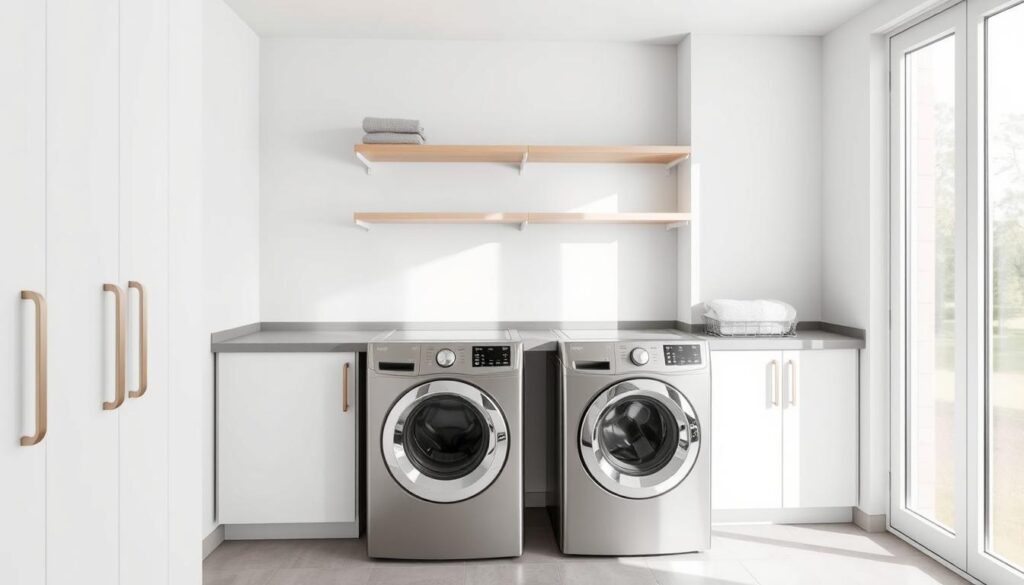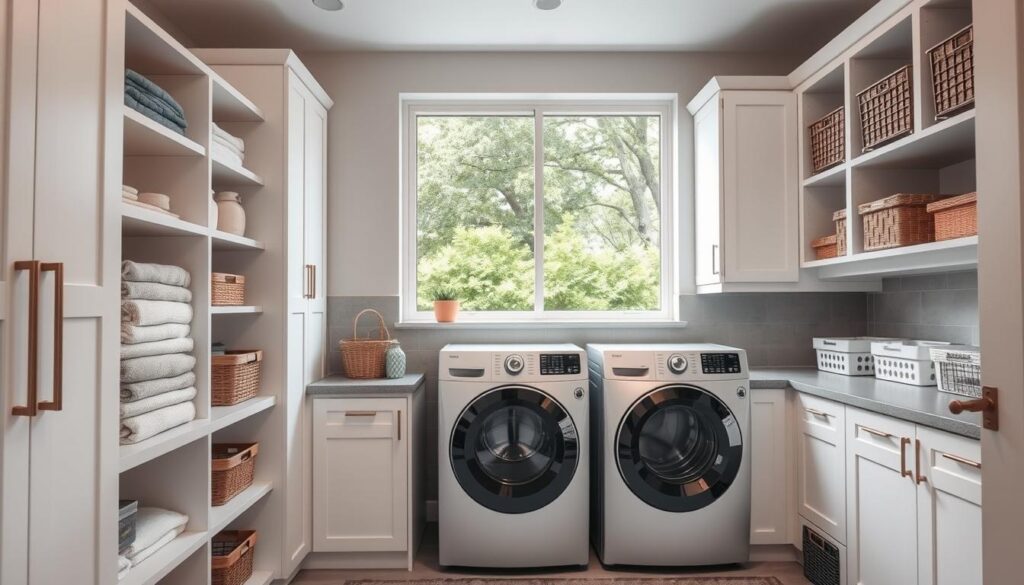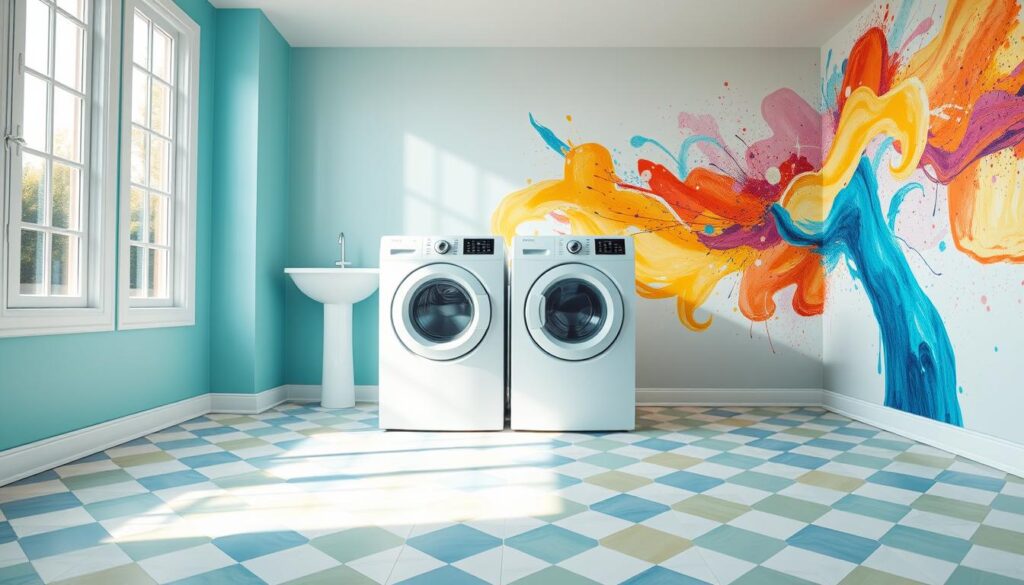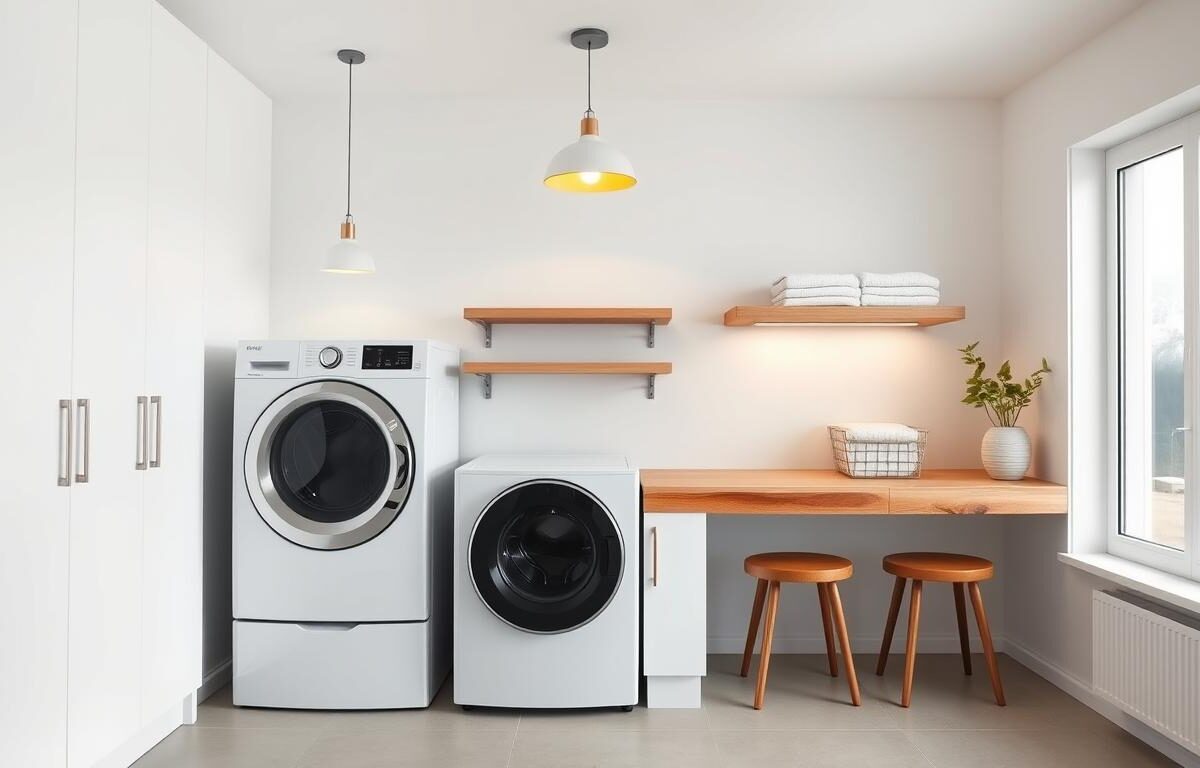What if folding clothes became the highlight of your day? Modern homes are reimagining their most practical areas as stylish, multi-functional hubs. Leading experts like Christina Nielsen and David Frazier prove that even task-focused zones can balance smart organization with eye-catching aesthetics.
Today’s top trends blend sleek tech integrations with clever storage hacks. Think pull-out drying racks beside built-in sorting stations, or vintage-inspired sinks paired with energy-efficient appliances. Massucco Warner’s recent projects showcase how contrasting textures and strategic lighting elevate mundane chores into pleasant routines.
Color plays a vital role too. Soft sage greens or warm neutrals create calm, while geometric tiles add personality to compact layouts. The secret? Treat this space like any other living area – prioritize flow, comfort, and visual harmony.
Key Takeaways
- Top designers combine practical layouts with appealing aesthetics for high-traffic areas
- Smart storage solutions maximize functionality in tight spaces
- Color psychology impacts how we experience daily tasks
- Mixed materials (like zinc tubs + quartz counters) add depth
- Proper lighting reduces eye strain during long sessions
- Tech upgrades (Wi-Fi appliances) streamline routines
Getting Started: Planning Your Laundry Room Makeover
Transforming your chore zone starts with smart prep work. Take designer Marea Clark’s approach: she turned a cramped closet into a dual-purpose laundry and mudroom for parents of twins. This proves how thoughtful planning unlocks hidden potential in even the trickiest layouts.
Assessing Your Space and Needs
Begin by measuring your area’s dimensions and checking existing plumbing or electrical points. Ask yourself: How many loads do you wash weekly? Do you handle delicate fabrics or oversized blankets? Jot down frustrations like poor lighting or missing counter space. Stephanie Sabbe’s clients loved her eye-level control panels that cut ironing time by 30% – a fix born from specific pain points.
Defining Style and Functionality Goals
Balance beauty with practicality. If you’re drawn to farmhouse charm, consider open shelving for easy access to detergents. Urban dwellers might prefer sleek cabinets hiding appliances. One homeowner combined pet supplies storage with folding stations using pull-out trays. Whatever your vision, ensure it aligns with:
- Daily routines (quick cycles vs. deep-cleaning needs)
- Household size (single vs. family-sized hampers)
- Budget-friendly upgrades (peel-and-stick backsplashes)
Functional Layouts for a Streamlined Laundry Room
The right layout can turn tedious tasks into smooth routines. Start by evaluating your washer and dryer placement – these workhorses deserve strategic positioning. Modern units like LG’s single appliance with eye-level controls or GE Profile’s ventless combo prove space-saving solutions don’t sacrifice convenience.

Optimizing Space for Washer and Dryer
Stack vertical setups in tight areas to free up floor space. Leave 3-6 inches around appliances for ventilation and easy maintenance. Front-load models on pedestals reduce bending, while ventless combos let you install machines anywhere with an outlet.
Flow and Accessibility Considerations
Create a clockwise workflow: sorting bins → washer → dryer → folding station. Keep doors and pathways clear – you’ll appreciate not dodging baskets mid-cycle. Designers often position washers left of dryers to match natural right-handed movements.
- Use zones to separate dirty/clean items
- Elevate controls for arthritis-friendly access
- Add slide-out trays between units for supplies
Remember: Your laundry room’s efficiency depends on how well the layout supports your habits. Test different configurations before finalizing!
Smart Storage and Organization Ideas
Imagine a space where every detergent bottle has its place and towels double as decor. Interior designer Becky Shea proves storage can be both practical and pretty. Her secret? Mixing display-worthy solutions with hidden helpers. Dee Murphy takes a similar approach, using fluted-glass cabinets to soften the look of necessities.

Open Shelving Versus Closed Cabinets
Open shelves shine for daily essentials. They let you grab stain removers quickly and showcase stylish baskets. But closed cabinets hide bulk buys and messy tools. Check this comparison:
| Feature | Open Shelving | Closed Cabinets |
|---|---|---|
| Accessibility | Instant access | Requires opening |
| Aesthetic | Displays decor | Hides clutter |
| Best For | Frequent-use items | Seasonal supplies |
| Maintenance | Weekly dusting | Wipe as needed |
Shea recommends “keeping detergent pods in matching jars on shelves” for a pulled-together look. Murphy prefers frosted cabinet doors that hint at contents without revealing chaos.
Innovative Baskets and Jars for Small Items
Don’t let socks disappear into oblivion. Use lidded baskets for delicates and clear jars for loose buttons. Labeled bins help sort clothes by family member – no more mix-ups!
Try these space-savers:
- Magnetic tins for safety pins on appliance sides
- Pull-out trays under counters for dryer sheets
- Narrow rolling carts between machines for irons
As Shea notes: “Containers should work as hard as your washer.” Choose pieces that add charm while corralling tiny essentials.
Fresh and Functional: creative laundry room ideas for Every Home
Who says utility spaces can’t spark joy? Top designers are proving that even the most practical areas can dazzle. Christina Nielsen balances crisp white walls with sage-green cabinetry, creating a fresh yet grounded aesthetic. David Frazier elevates basic tasks through vintage acanthus-patterned fabrics on folding stations. Meanwhile, Massucco Warner mixes playful puffer fish wallpaper with hexagonal floor tiles – proof that bold contrasts work in compact zones.
Start by choosing colors that energize without overwhelming. Soft greens paired with ivory countertops keep things airy, while marigold-yellow accents add warmth. Follow this designer-approved formula for pattern mixing:
| Designer | Color Palette | Pattern Approach | Key Feature |
|---|---|---|---|
| Christina Nielsen | White + Sage | Subtle textures | Monochromatic harmony |
| David Frazier | Navy + Cream | Large-scale florals | Vintage textiles |
| Massucco Warner | Charcoal + Mustard | Geometric + Organic | 60/40 ratio |
Connect your space to nearby rooms through material choices. If your kitchen has brass fixtures, repeat that finish on cabinet pulls here. Use washable indoor-outdoor fabrics for curtains that match living room drapes. As Frazier notes: “A patterned skirt hiding your washer becomes instant art.”
Keep functionality front and center. Install pull-out drying racks above front-load machines, or add a fold-down counter over utility sinks. These smart touches prove practical spaces can feel special – no cape cod charm required.
Color and Pattern: Adding Visual Appeal to Your Laundry Space
Why settle for beige when your chore zone could burst with personality? Designers are ditching predictable palettes for imaginative combinations that energize daily routines. Take Marea Clark’s pastel pink cabinetry – a refreshing twist on traditional blues and greens. Or Tineke Triggs’ whimsical wallpaper, transforming a cramped corner into a chic retreat.

Wallpaper, Tile, and Pattern Play
Strategic pattern mixing creates depth without chaos. Jenna Gross proves this with large-scale Stroheim prints in tight spaces, while Dina Bandman’s navy-blue landscape tiles become instant focal points. Follow this formula for success:
| Element | Scale | Effect |
|---|---|---|
| Wallpaper | Large | Adds drama |
| Floor Tile | Small | Grounds the space |
| Cabinet Fronts | Medium | Bridges contrasts |
“A bold wall covering makes sorting socks feel like gallery work,” notes Triggs. Pair vibrant patterns with matte finishes to prevent sensory overload.
Pastel Accents and Bold Color Statements
Soft hues calm, while saturated tones energize. Clark’s blush cabinetry pairs perfectly with white counters, creating a serene backdrop. For impact, try marigold-yellow bins or deep navy shelving – colors proven to boost mood during repetitive tasks.
Remember these tips:
- Use bright shades on lower cabinets to anchor the space
- Paint ceilings in pale blue to mimic sky views
- Repeat accent colors in storage baskets for cohesion
As Bandman advises: “Treat walls as canvases, not afterthoughts.” Whether through tile murals or daring paint choices, let your color strategy reflect how you want to feel while folding towels.
Design Accents: Mixing Vintage Touches with Modern Flair
Blending eras in your utility space creates a timeless charm that modernizes daily chores. Cloth & Kind proves this approach works by installing a vintage zinc tub as a sink – its weathered patina contrasts beautifully with sleek appliances. This balance of old and new transforms ordinary tasks into moments of visual delight.
Rustic Fixtures and Antique Elements
Authentic pieces add soul to functional areas. Designer April Tomlin pairs retro carts with skirted sinks, proving practicality can have personality. Plain English Kitchens demonstrates how brass faucets elevate rust-toned cabinetry, merging traditional design with contemporary convenience.
Follow these principles for harmonious mixing:
- Anchor the space with one standout antique – like an 1800s washbasin or reclaimed wood counter
- Pair weathered metals with matte black appliances for contrast
- Use open shelving to display ceramic detergent jars alongside modern stain removers
Tomlin notes: “A vintage laundry cart isn’t just storage – it’s a conversation starter that makes folding feel special.” Keep hardware consistent across eras – brass drawer pulls complement both farmhouse sinks and Wi-Fi-enabled dryers.
Remember functionality. Weathered baskets should hold lint rollers, while antique cabinets need to fit bulk detergent packs. When done right, these touches create a style that’s as efficient as it is inviting.
Brightening Up: Lighting and Ventilation Solutions
Lighting isn’t just functional—it’s the secret ingredient to a welcoming utility area. Chandos Interiors transformed a cramped space using breezy blue walls and unobstructed windows, proving smart illumination choices elevate both mood and efficiency.
Maximizing Natural Light
Lisa Frantz’s textured cast glass doors demonstrate how to borrow sunlight from adjacent rooms. These translucent panels maintain privacy while doubling available brightness—perfect for hallways or interior walls without direct windows.
Linda Hayslett’s all-white cabinetry approach keeps spaces feeling airy. Pair with matte finishes to avoid glare, or add metallic accents that catch daylight. Consider these surface strategies:
| Element | Finish | Light Boost |
|---|---|---|
| Walls | Glossy | Reflects 80% light |
| Floors | Semi-gloss | Bounces upward |
| Countertops | Quartz | Diffuses evenly |
Install ventilation fans with humidity sensors—they automatically clear steam while you sort loads. “Layer lighting like you layer outfits,” advises Frantz. Combine recessed ceiling fixtures with under-cabinet LED strips for task areas.
Time your upgrades wisely. Swap heavy drapes for cellular shades during appliance replacements to maintain workflow. Proper airflow prevents musty odors, making every laundry session feel fresher.
Incorporating Technology: Smart Appliances and Controls
Modern appliances are reshaping how households tackle chores. Stephanie Sabbe’s LG washer-dryer combo proves this shift – its eye-level controls reduce back strain while speeding up cycles. GE Profile’s ventless units take flexibility further, letting you install machines anywhere with a power outlet.
Smart features now go beyond basic timers. Wi-Fi connectivity lets you start loads remotely or receive phone alerts when towels finish drying. Energy-efficient models cut utility bills over time, with some using 40% less water per cycle.
| Feature | LG Single Unit | GE Combo | Benefits |
|---|---|---|---|
| Controls | Eye-level panel | Touchscreen display | Reduces bending |
| Installation | Stackable | Ventless design | Fits tight spaces |
| Special Cycles | 15 options | Steam refresh | Preserves fabrics |
Prioritize intuitive interfaces for multi-generational homes. Front-mounted dials and voice commands make laundry simpler for those with limited mobility. “Tech should adapt to your habits, not the reverse,” notes Sabbe.
Ventless dryers eliminate complex ductwork – ideal for apartments or basement setups. Pair them with pedestal drawers storing detergent pods at arm’s reach. These innovations transform tedious tasks into streamlined routines.
Mini DIY Projects to Personalize Your Laundry Area
Your utility space deserves as much personality as your living room. Simple upgrades transform basic functionality into a reflection of your style while boosting efficiency. Let’s explore hands-on solutions that marry practicality with self-expression.
DIY Built-In Units and Customized Shelving
Live Pretty on a Penny proves stacked appliances shine when framed by custom shelving. Use plywood to build wrap-around storage that hides detergent bottles and displays decorative baskets. Narrow ledges between machines hold stain sticks within reach.
Vintage Revivals maximizes vertical space with DIY closet rods above doors. These provide perfect drying spots for delicates without sacrificing floor area. For tight layouts, install fold-down counters that double as folding stations.
Creative Drying Racks and Accessory Ideas
DIY in PDX’s fold-into-wall rack disappears when not needed – ideal for small laundry areas. Repurpose vintage shutters as foldable drying rack surfaces, or mount tension rods under cabinets for lingerie.
Add flair with labeled linen bags and painted mason jars. Try chalkboard panels on cabinet fronts for task lists. As one homeowner shared: “A rainbow of clothespins in a repurposed toolbox makes line-drying feel festive.”

